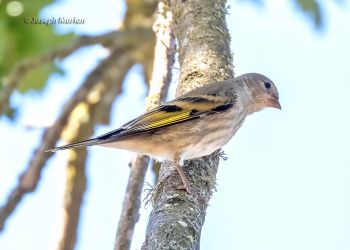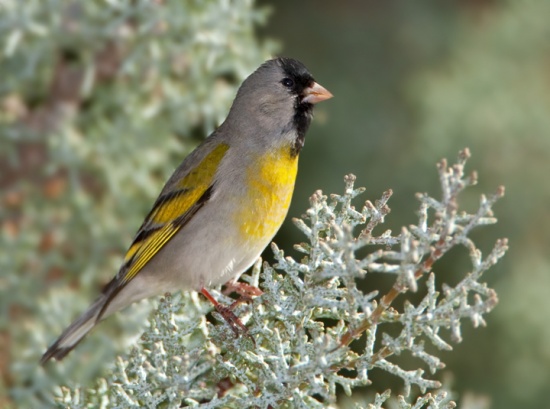- Spinus lawrencei
Carduelis lawrencei
Identification
12 cm. Gray, yellow rump, yellow wing bars, black tail with white band, pink-gray bill, black cap. Females browner, less yellow, no black.
Juveniles resemble females but are even duller and have faint streaks on the upperparts and especially the underparts.
Distribution

Photo © by Joseph Morlan
Joseph D. Grant County Park, Mount Hamilton, San Jose, California, USA, 2 June 2021
Southwestern United States and northern Mexico. Breeds in interior California and northern Baja California, dispersing in winter to Sonora and southern Arizona. Some non-breeding individuals spend the summer in the winter range. Vagrants have been recorded in Nevada, New Mexico, and Texas.
Taxonomy
This species is remarkably homogeneous, with no subspecies, and according to one study, no genetic variation at the 23 loci tested (Davis 2001, citing Marten and Johnson 1986).
Formerly placed in genus Carduelis.
Habitat
Dry and open woods.
Behaviour
Diet
Diet includes seeds and mistletoe berries.
Breeding
It builds a loosely woven cup shaped nest in a fork of several small branches. 3-6, white with a blue or green tinge eggs are laid and incubated by the female for 12-13 days.
References
- Clements, J. F., T. S. Schulenberg, M. J. Iliff, D. Roberson, T. A. Fredericks, B. L. Sullivan, and C. L. Wood. 2015. The eBird/Clements checklist of birds of the world: v2015, with updates to August 2015. Downloaded from http://www.birds.cornell.edu/clementschecklist/download/
Recommended Citation
- BirdForum Opus contributors. (2025) Lawrence's Goldfinch. In: BirdForum, the forum for wild birds and birding. Retrieved 12 May 2025 from https://www.birdforum.net/opus/Lawrence%27s_Goldfinch
External Links
GSearch checked for 2020 platform.





